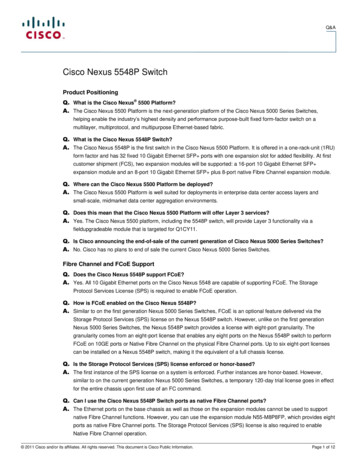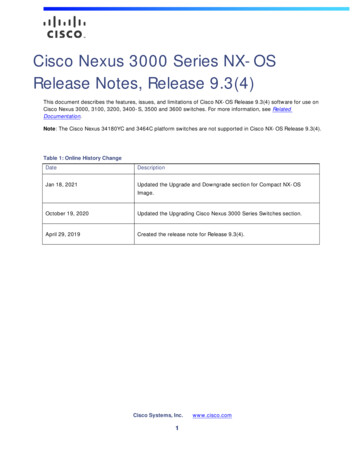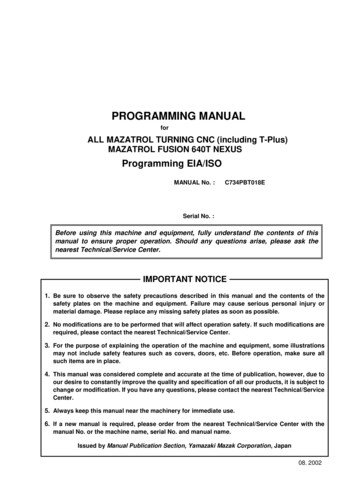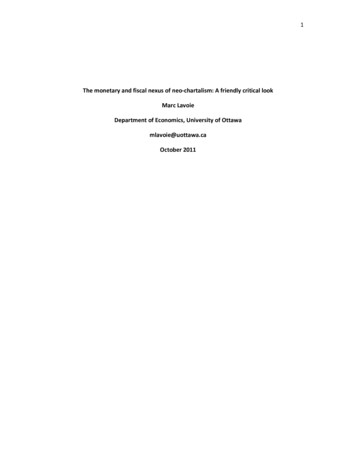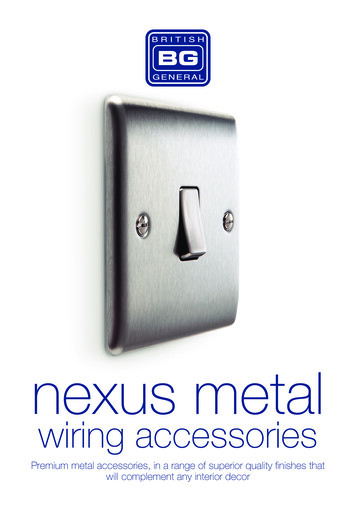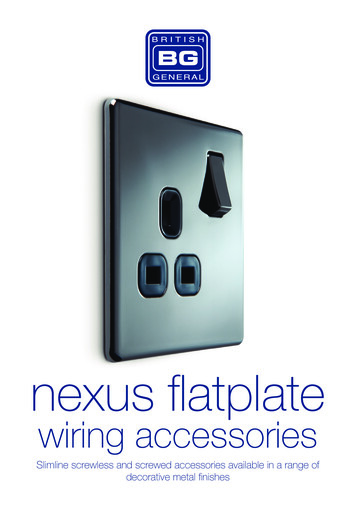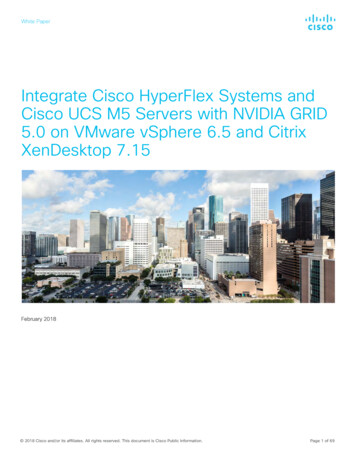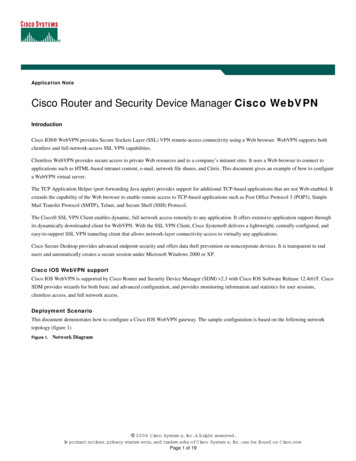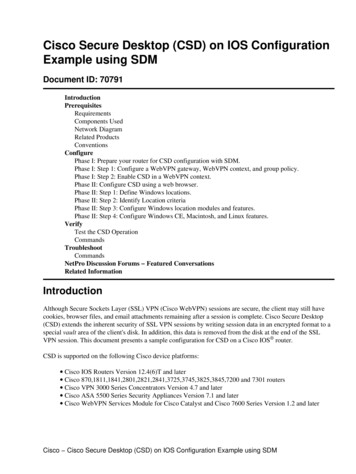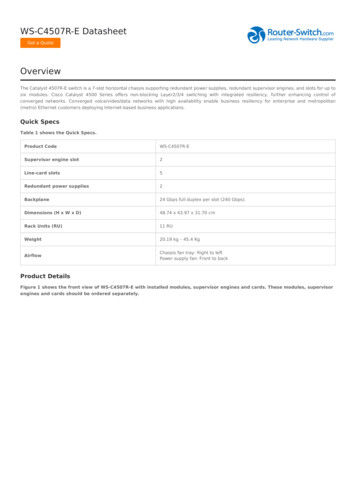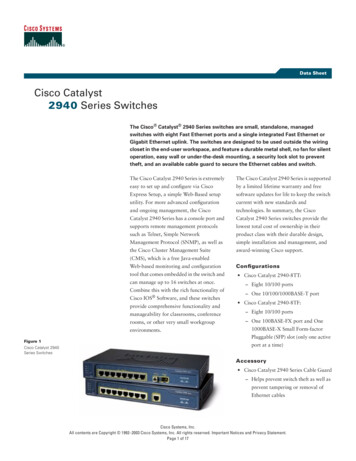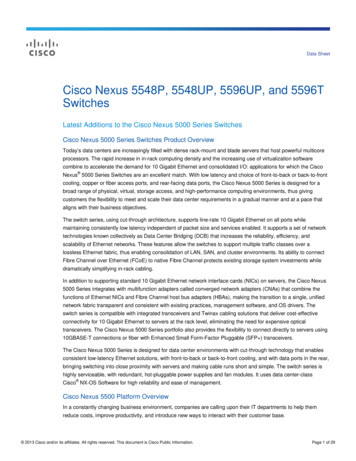
Transcription
Data SheetCisco Nexus 5548P, 5548UP, 5596UP, and 5596TSwitchesLatest Additions to the Cisco Nexus 5000 Series SwitchesCisco Nexus 5000 Series Switches Product OverviewToday’s data centers are increasingly filled with dense rack-mount and blade servers that host powerful multicoreprocessors. The rapid increase in in-rack computing density and the increasing use of virtualization softwarecombine to accelerate the demand for 10 Gigabit Ethernet and consolidated I/O: applications for which the CiscoNexus 5000 Series Switches are an excellent match. With low latency and choice of front-to-back or back-to-frontcooling, copper or fiber access ports, and rear-facing data ports, the Cisco Nexus 5000 Series is designed for abroad range of physical, virtual, storage access, and high-performance computing environments, thus givingcustomers the flexibility to meet and scale their data center requirements in a gradual manner and at a pace thataligns with their business objectives.The switch series, using cut-through architecture, supports line-rate 10 Gigabit Ethernet on all ports whilemaintaining consistently low latency independent of packet size and services enabled. It supports a set of networktechnologies known collectively as Data Center Bridging (DCB) that increases the reliability, efficiency, andscalability of Ethernet networks. These features allow the switches to support multiple traffic classes over alossless Ethernet fabric, thus enabling consolidation of LAN, SAN, and cluster environments. Its ability to connectFibre Channel over Ethernet (FCoE) to native Fibre Channel protects existing storage system investments whiledramatically simplifying in-rack cabling.In addition to supporting standard 10 Gigabit Ethernet network interface cards (NICs) on servers, the Cisco Nexus5000 Series integrates with multifunction adapters called converged network adapters (CNAs) that combine thefunctions of Ethernet NICs and Fibre Channel host bus adapters (HBAs), making the transition to a single, unifiednetwork fabric transparent and consistent with existing practices, management software, and OS drivers. Theswitch series is compatible with integrated transceivers and Twinax cabling solutions that deliver cost-effectiveconnectivity for 10 Gigabit Ethernet to servers at the rack level, eliminating the need for expensive opticaltransceivers. The Cisco Nexus 5000 Series portfolio also provides the flexibility to connect directly to servers using10GBASE-T connections or fiber with Enhanced Small Form-Factor Pluggable (SFP ) transceivers.The Cisco Nexus 5000 Series is designed for data center environments with cut-through technology that enablesconsistent low-latency Ethernet solutions, with front-to-back or back-to-front cooling, and with data ports in the rear,bringing switching into close proximity with servers and making cable runs short and simple. The switch series ishighly serviceable, with redundant, hot-pluggable power supplies and fan modules. It uses data center-classCisco NX-OS Software for high reliability and ease of management.Cisco Nexus 5500 Platform OverviewIn a constantly changing business environment, companies are calling upon their IT departments to help themreduce costs, improve productivity, and introduce new ways to interact with their customer base. 2013 Cisco and/or its affiliates. All rights reserved. This document is Cisco Public Information.Page 1 of 29
The Cisco Nexus 5500 platform extends the industry-leading versatility of the Cisco Nexus 5000 Series purposebuilt 10 Gigabit Ethernet data center-class switches and provides innovative advances toward higher density, lowerlatency, and multilayer services. The Cisco Nexus 5500 platform is well suited for enterprise-class data centerserver access-layer deployments across a diverse set of physical, virtual, storage-access, and high-performancecomputing (HPC) data center environments.Cisco Nexus 5548P SwitchThe Cisco Nexus 5548P Switch (Figure 1) is the first of the Cisco Nexus 5500 platform switches. It is a one-rackunit (1RU) 10 Gigabit Ethernet and FCoE switch offering up to 960-Gbps throughput and up to 48 ports. The switchhas 32 1/10-Gbps fixed SFP Ethernet and FCoE ports and one expansion slot.Figure 1.Cisco Nexus 5548P SwitchCisco Nexus 5548UP SwitchThe Cisco Nexus 5548UP (Figure 2) is a 1RU 10 Gigabit Ethernet, Fibre Channel, and FCoE switch offering up to960 Gbps of throughput and up to 48 ports. The switch has 32 unified ports and one expansion slot.Figure 2.Cisco Nexus 5548UP SwitchCisco Nexus 5596UP SwitchThe Cisco Nexus 5596UP Switch (Figure 3) is a 2RU 10 Gigabit Ethernet, Fibre Channel, and FCoE switch offeringup to 1920 Gbps of throughput and up to 96 ports. The switch has 48 unified ports and three expansion slots.Figure 3.Cisco Nexus 5596UP Switch Configured with Three 16-Port Expansion Modules 2013 Cisco and/or its affiliates. All rights reserved. This document is Cisco Public Information.Page 2 of 29
Cisco Nexus 5596T SwitchThe Cisco Nexus 5596T Switch (Figure 4) is a 2RU form factor, with 32 fixed ports of 10G BASE-T and 16 fixedports of SFP . The switch also supports up to three expansion slots. The switch supports 10 Gigabit Ethernet (fiberand copper), Fibre Channel, and FCoE, offering up to 1920 Gbps of throughput and up to 96 ports. The switchsupports unified ports on all SFP ports. The 10G BASE-T ports support FCoE up to 30m distance with Category6a and Category 7 cables.Figure 4.Cisco Nexus 5596T Switch Configured with three 12-Port 10G BASE-T Expansion ModulesExpansion Module Options for the Cisco Nexus 5548P, 5548UP, 5596UP, and 5596TSwitchesThe Cisco Nexus 5500 platform is equipped with expansion modules that can be used to increase the number of10 Gigabit Ethernet, 40 Gigabit Ethernet and FCoE ports or to connect to Fibre Channel SANs with 8/4/2/1-GbpsFibre Channel switch ports, or both.The Cisco Nexus 5548P and 5548UP supports two expansion module, and the Cisco Nexus 5596UP and 5596Tsupport four expansion modules from the following offerings (Figure 5): Ethernet module that provides sixteen 1/10 Gigabit Ethernet and FCoE ports using the SFP interface. Fibre Channel plus Ethernet module that provides eight 1/10 Gigabit Ethernet and FCoE ports using theSFP interface, and eight ports of 8/4/2/1-Gbps native Fibre Channel connectivity using the SFP /SFPinterface. Unified port module that provides up to sixteen 1/10 Gigabit Ethernet and FCoE ports using the SFP interface or up to sixteen ports of 8/4/2/1-Gbps native Fibre Channel connectivity using the SFP and SFPinterfaces; the use of 1/10 Gigabit Ethernet or 8/4/2/1-Gbps Fibre Channel on a port is mutually exclusivebut can be selected for any of the 16 physical ports per module. Four port QSFP Ethernet module that provides 4 40 Gigabit Ethernet ports using QSFP interface. EachQSFP 40GE port can only work in 4x10G mode and supports DCB and FCoE.Figure 5.From Left to Right: 16-Port 1 and 10 Gigabit Ethernet and FCoE Module, 8-Port Fibre Channel Plus 8-Port 1 and10 Gigabit Ethernet and FCoE Module, 16 port Unified Port Module and 4 port QSFP module.The Cisco Nexus 5596T also supports another expansion module: Ethernet module (Figure 6) that provides twelve 10G BASE-T ports; The 10G BASE-T ports support FCoEup to 30m distance with Category 6a and Category 7 cables. 2013 Cisco and/or its affiliates. All rights reserved. This document is Cisco Public Information.Page 3 of 29
Figure 6.12-Port 10G BASE-T Expansion Module (Front View and Side View)Layer 3 Daughter Card and Expansion Module Options for Cisco Nexus 5548P, 5548UP,5596UP, and 5596T Switches In addition to these expansion modules, the Cisco Nexus 5548P and 5548UP support a Layer 3 daughtercard that can be ordered with the system or as a spare (field upgradable). This daughter card provides up to160 Gbps of Layer 3 forwarding capability (240 million packets per second [mpps]) that can be shared by all48 ports in the chassis. As shown in Figure 7, the Layer 3 daughter card does not take up one of theexpansion slots on the rear of the chassis, but instead is installed by replacing the Layer 2 I/O module(N55-DL2) that is located on the front of the chassis.Figure 7. Layer 3 Daughter Card on the Cisco Nexus 5548UP SwitchIn addition to these expansion modules, the Cisco Nexus 5596UP and 5596T support a Layer 3 module thatprovides up to 160 Gbps of Layer 3 forwarding capability (240 mpps) that can be shared by all the I/O portsin the chassis (Figure 8).Figure 8. Layer 3 Module (Front View and Side View)Version 2 of Layer 3 daughter cards and expansion modules have enhanced capabilities that increase thehost table size from 8000 to 16,000 entries, or multicast routes from 4000 to 8000 starting from softwarerelease Cisco NX-OS Software Release 5.2(1)N1(1b) and later. Requires free of charge a base LAN license (N55-BAS1k9 ) to be installed. This is included in the hardwarepurchase; however the license would need to be manually installed.Cisco Nexus 2000 Series Fabric ExtendersThe Cisco Nexus 2000 Series Fabric Extenders comprise a category of data center products that provide auniversal server-access platform that scales across a multitude of 1 Gigabit Ethernet, 10 Gigabit Ethernet, unifiedfabric, rack, and blade server environments. The Cisco Nexus 2000 Series Fabric Extenders are designed tosimplify data center architecture and operations by meeting the business and application needs of a data center. 2013 Cisco and/or its affiliates. All rights reserved. This document is Cisco Public Information.Page 4 of 29
Working in conjunction with Cisco Nexus switches, the Cisco Nexus 2000 Series Fabric Extenders offer acost effective and efficient way to support today’s Gigabit Ethernet environments while allowing easy migration to10 Gigabit Ethernet, virtual machine-aware Cisco unified fabric technologies.The Cisco Nexus 2000 Series design is aligned with the design of servers. It offers front-to-back or back-to-frontcooling, compatibility with data center hot-aisle and cold-aisle designs, placement of all switch ports at the rear ofthe unit in close proximity to server ports, and accessibility of all user-serviceable components from the front panel.The Cisco Nexus 2000 Series is built for nonstop operation, with redundant hot-swappable power supplies and ahot-swappable fan tray with redundant fans. Its compact 1RU form factor takes up relatively little space, making iteasy to incorporate into rack designs (Figure 9).Figure 9.Cisco Nexus 2000 Series Fabric Extenders from Bottom Right to Top Left: Cisco Nexus 2224TP GE, 2248TP GE,2248TP-E GE, 2232TM 10GE, 2232TM-E 10GE, 2232PP 10GE and 2248 PQ 10GEThe Cisco Nexus 2000 Series provides two types of ports: ports for end-host attachment (host interfaces) anduplink ports (fabric interfaces). Fabric Interfaces are differentiated with a yellow color for connectivity to theupstream parent Cisco Nexus switch.Table 1 lists the Cisco Nexus 2000 Series Fabric Extenders. Fabric extenders can be mixed and matched to aparent switch to provide connectivity options.Table 1.Cisco Nexus 2000 Series SpecificationsDescriptionSpecificationMinimum SoftwareCisco NX-OS ReleaseCisco Nexus 2224TP24 100/1000BASE-T host interfaces and 2 10 Gigabit Ethernet fabric interfaces (SFP )4.2(1)N2(1)Cisco Nexus 2248TP48 100/1000BASE-T host interfaces and 4 10 Gigabit Ethernet fabric interfaces (SFP )4.2(1)N2(1)Cisco Nexus 2248TP-E48 100/1000BASE-T host interfaces and 4 10 Gigabit Ethernet fabric interfaces (SFP )[32MB Shared Buffer]5.1(3)N1(1)Cisco Nexus 2232PP32 1/10 Gigabit Ethernet and FCoE host interfaces (SFP ) and 8 10 Gigabit Ethernet andFCoE fabric interfaces (SFP )4.2(1)N2(1)Cisco Nexus 2248PQ48 1/10 Gigabit Ethernet and FCoE host interfaces (SFP ) and four QSFP GigabitEthernet and FCoE fabric interfaces (QSFP )6.0(2)N1(1)Cisco Nexus 2232TM32 1/10 G BASE-T host interfaces and 8 10 Gigabit Ethernet (SFP ) Uplink Module5.0(3)N2(1)Cisco Nexus 2232TM-E32 1/10 G BASE-T host interfaces and 8 10 Gigabit Ethernet (SFP ) Uplink Module (Lowerpower consumption and improved BER)5.2(1)N1(1)Cisco Nexus B22HP16x 1/10 G BASE-KR internal host interfaces and 8 10 Gigabit Ethernet fabric interfaces(SFP ) Network Interfaces5.0(3)N2(1)Cisco Nexus B22F16x 10 G BASE-KR internal host interfaces and 8 10 Gigabit Ethernet fabric interfaces(SFP ) Network Interfaces5.2(1)N1(1)Cisco Nexus B22DELL16x 10 G BASE-KR internal host interfaces and 8 10 Gigabit Ethernet fabric interfaces(SFP ) Network Interfaces6.0(2)N1(1)The Cisco Nexus 2224TP, 2248TP, and 2248TP-E provide port density options for highly scalable 100-Mbpsand Gigabit Ethernet connectivity. The Cisco Nexus 2232PP provides ease of migration from Gigabit Ethernet to10 Gigabit Ethernet while supporting highly scalable 10 Gigabit environments. 2013 Cisco and/or its affiliates. All rights reserved. This document is Cisco Public Information.Page 5 of 29
The Cisco Nexus 2248TP-E Fabric Extender is a general-purpose 1 Gigabit Ethernet fabric extender withenhancements that target workloads such as large-volume databases, distributed storage, and video editing. Justlike the Cisco Nexus 2248TP, the Cisco Nexus 2248TP-E also supports 48 100/1000BASE-T host facing ports andfour 10 Gigabit Ethernet fabric interfaces.The Cisco Nexus 2232TM-E Fabric Extender supports scalable 1/10GBASE-T environments, ease of migrationfrom 1GBASE-T to 10GBASE-T, and effective reuse of existing structured cabling. It comes with an uplink modulethat supports eight 10 Gigabit Ethernet fabric interfaces. It is a superset of the Cisco Nexus 2232TM with the latestgeneration of 10GBASE-T PHY, enabling lower power and improved bit error rate (BER). The Cisco Nexus2232TM-E supports DCB and LAN and SAN consolidation.The Cisco Nexus 2232PP 1/10GE Fabric Extender is the ideal platform for migration from Gigabit Ethernet to10 Gigabit Ethernet and unified fabric environments. It supports FCoE and a set of network technologies knowncollectively as Data Center Bridging (DCB) that increase the reliability, efficiency, and scalability of Ethernetnetworks. These features allow the switches to support multiple traffic classes over a lossless Ethernet fabric, thusenabling consolidation of LAN, SAN, and cluster environments.The Cisco Nexus 2248PQ 10 Gigabit Ethernet Fabric Extender is the newest member of the Cisco Nexus FabricExtender Family. It supports high- density 10 Gigabit Ethernet environments and has 48 forty-eight 1/10 GigabitEthernet SFP host ports and 4 QSFP fabric ports (16 x 10 GE fabric ports). QSFP connectivity simplifiescabling while lowering power and solution cost. The Cisco Nexus 2248PQ 10GE Fabric Extender supports FCoEand a set of network technologies known collectively as Data Center Bridging (DCB) that increase the reliability,efficiency, and scalability of Ethernet networks. These features allow support for multiple traffic classes over alossless Ethernet fabric, thus enabling consolidation of LAN, storage area network (SAN), and clusterenvironments.The Cisco Nexus B22HP Fabric Extender (Figure 10) for HP Blade System is the first 10 Gigabit Ethernet andFCoE fabric extender in a third-party blade chassis format. It is targeted at customers who already own HP bladeservers and makes it easier for them to integrate with the Cisco Nexus data center fabric.Figure 10.From Left to Right: Cisco Nexus B22HP Fabric Extender, Cisco Nexus B22F Fabric Extender, Cisco NexusB22DELL Fabric ExtenderThe Cisco Nexus B22F (Figure 10) Fabric Extender for Fujitsu BladeSystem is the 10 Gigabit Ethernet and FCoEfabric extender in a third-party blade chassis format. It is targeted at customers who already own Fujitsu bladeservers and makes it easier for them to integrate with the Cisco Nexus data center fabric.The Cisco Nexus B22DELL (Figure 10) Fabric Extender for Dell Blade System is the 10 Gigabit Ethernet and FCoEfabric extender in a third-party blade chassis format. It is targeted at customers who already own Dell blade serversand makes it easier for them to integrate with the Cisco Nexus data center fabric.Cisco Nexus 2000 Series Fabric Extenders connect to a parent Cisco Nexus switch through their fabric links usingCX1 copper cable, short-reach or long-reach optics, and the cost-effective Cisco Fabric Extender Transceivers.Cisco Fabric Extender Transceivers are optical transceivers that provide a highly cost-effective solution forconnecting the fabric extender to its parent switch. 2013 Cisco and/or its affiliates. All rights reserved. This document is Cisco Public Information.Page 6 of 29
Cisco Nexus 2000 Series and Cisco Nexus 5000 Series Deployment ScenariosThe fabric extenders can be used in the following deployment scenarios: Rack servers with 100 Megabit Ethernet, Gigabit Ethernet, or 10 Gigabit Ethernet network interface cards(NICs); the fabric extender can be physically located at the top of the rack and the Cisco Nexus 5000 Seriesswitch can reside in the middle or at the end of the row, or the fabric extender and the Cisco Nexus 5000Series switch can both reside at the end or middle of the row. Mixed Gigabit Ethernet and 10 Gigabit Ethernet environments in which rack servers are running at eitherspeeds in the same rack or in adjacent racks. 10 Gigabit Ethernet and FCoE deployments, using servers with converged network adapters (CNAs) forunified fabric environments with the Cisco Nexus 2232PP. 1/10 Gigabit Ethernet BASE-T server connectivity with ease of migration from 1 to 10GBASE-T andeffective reuse of structured cabling. Server racks with integrated lights-out (iLO) management, with 100 Megabit Ethernet or Gigabit Ethernetmanagement and iLO interfaces. Gigabit Ethernet and 10 Gigabit Ethernet blade servers with pass-through blades. Low-latency, high-performance computing environments. Virtualized access. Cisco Nexus 2000 Series Fabric Extenders can single or dual-connect (using Enhanced vPC) to twoupstream Cisco Nexus 5500 platform switches (Figure 11). Servers or end host can connect to single or dual Cisco Nexus 2000 Series Fabric Extenders using NICteaming (Figure 11) when the parent Cisco Nexus 5500 platform has Enhanced vPC enabled. Cisco Nexus 5500 platform switches do not support enhanced vPC. Hence, vPC is supported only betweenCisco Nexus 2000 Series Fabric Extenders and Cisco Nexus 5500 platform switches or between serversusing NIC teaming and Cisco Nexus 2000 Series Fabric Extenders. (Note: In the latter case, vPC is notallowed between Cisco Nexus 2000 Series Fabric Extenders and Cisco Nexus 5500 platform switches).Figure 11.Deployment Scenario 2013 Cisco and/or its affiliates. All rights reserved. This document is Cisco Public Information.Page 7 of 29
Efficient Transceiver and Cabling OptionsThe Cisco Nexus 5500 platform supports a wide variety of 1 and 10 Gigabit Ethernet connectivity options usingCisco 10GBASE SFP modules.In addition, the Cisco Nexus 5500 platform supports 1 Gigabit Ethernet connectivity options using 1GBASE SFPmodules, 8/4/2 -Gbps Fibre Channel SFP and 4/2/1-Gbps Fibre Channel SFP interfaces are supported withexpansion module options.Table 2 lists the supported transceiver options.Table 2.Cisco Nexus 5500 Platform Transceiver Support MatrixCisco SFPDescriptionFET-10G10-Gbps SFP module for Cisco Nexus 2000 Series to Cisco Nexus 5000 Series connectivityCisco SFP-10G-SR10GBASE-SR SFP module (multimode fiber [MMF])Cisco SFP-10G-LR10GBASE-LR SFP module (single-mode fiber [SMF])Cisco SFP-10G-ER10GBASE-ER-SFP module (single-mode fiber[SMF])Cisco SFP-H10GB-CU1M10GBASE-CU SFP cable 1m (Twinax cable)Cisco SFP-H10GB-CU3M10GBASE-CU SFP cable 3m (Twinax cable)Cisco SFP-H10GB-CU5M10GBASE-CU SFP cable 5m (Twinax cable)Cisco SFP-H10GB-ACU7M10GBASE-CU SFP cable 7m (active Twinax cable)Cisco SFP-H10GB-ACU10M10GBASE-CU SFP cable 10m (active Twinax cable)Cisco GLC-T1000BASE-T SFPGLC-ZX-SM1000BASE-ZX SFP transceiver module for SMF, 1550-nm wavelength, dual
This document is Cisco Public Information. Page 1 of 29 Data Sheet Cisco Nexus 5548P, 5548UP, 5596UP, and 5596T Switches . server access-layer deployments across a diverse set of physical, virtual, storage-access, and h
